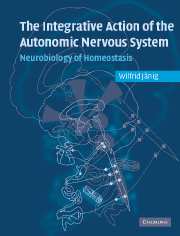Book contents
- Frontmatter
- Contents
- Foreword
- Preface
- List of abbreviations
- Introduction
- Part I The autonomic nervous system: functional anatomy and visceral afferents
- Part II Functional organization of the peripheral autonomic nervous system
- Part III Transmission of signals in the peripheral autonomic nervous system
- Part IV Central representation of the autonomic nervous system in spinal cord, brain stem and hypothalamus
- References
- Index
Part IV - Central representation of the autonomic nervous system in spinal cord, brain stem and hypothalamus
Published online by Cambridge University Press: 10 August 2009
- Frontmatter
- Contents
- Foreword
- Preface
- List of abbreviations
- Introduction
- Part I The autonomic nervous system: functional anatomy and visceral afferents
- Part II Functional organization of the peripheral autonomic nervous system
- Part III Transmission of signals in the peripheral autonomic nervous system
- Part IV Central representation of the autonomic nervous system in spinal cord, brain stem and hypothalamus
- References
- Index
Summary
In the preceding chapters I described that sympathetic and parasympathetic systems consist of many functionally separate pathways that supply the peripheral target organs. The neurons in these pathways have characteristic reflex discharge patterns, which are centrally generated. The final central output neurons are the preganglionic neurons in the spinal cord and in the brain stem. Integrative processes in general do not seem to occur between functionally distinct autonomic pathways but only within some non-vasoconstrictor pathways to viscera (see Chapter 4). The discharge patterns measured in postganglionic neurons are unlikely to be generated by qualitatively different discharge patterns in subpopulations of preganglionic neurons converging on the same postganglionic neuron, although we have no direct experimental proof for this. This does not collide with the finding that neurochemically different preganglionic neurons may converge on the same postganglionic neuron (Murphy et al. 1998). Thus, in the autonomic ganglia, the discharge patterns are not changed qualitatively, but may be modified quantitatively, i.e. enhanced by the converging synaptic input. At the neuroeffector junctions, temporal and spatial aspects of the neural signals transmitted to the effector cells contribute to transmission; furthermore, various non-neural signals may modulate the neuroeffector transmission pre- and postjunctionally.
This section will focus on some principles of the organization of central regulation of peripheral autonomic pathways integrated in the spinal cord, brain stem and hypothalamus.
- Type
- Chapter
- Information
- Integrative Action of the Autonomic Nervous SystemNeurobiology of Homeostasis, pp. 289 - 292Publisher: Cambridge University PressPrint publication year: 2006



